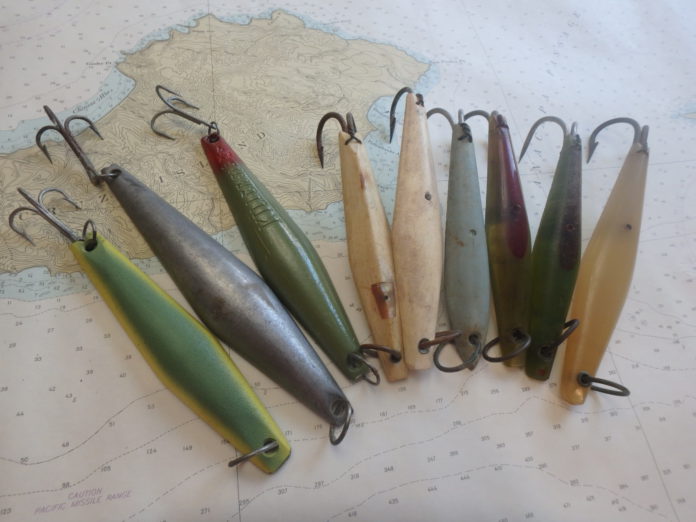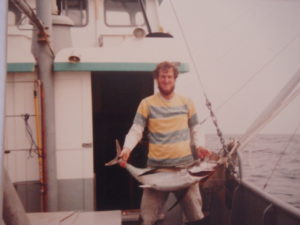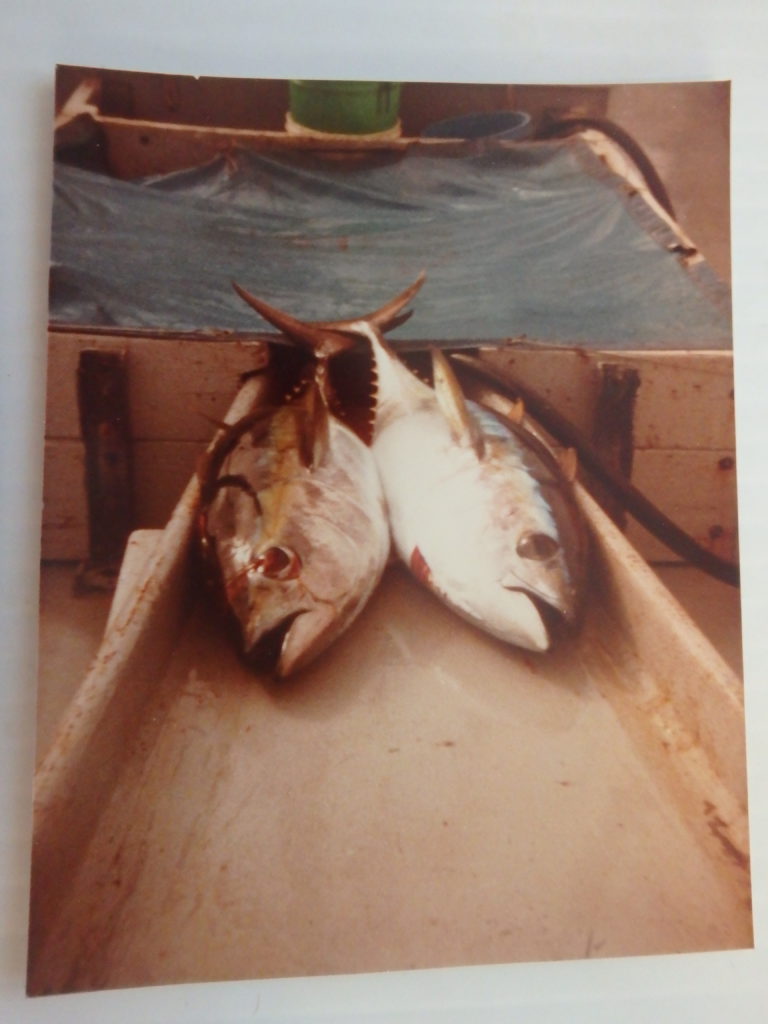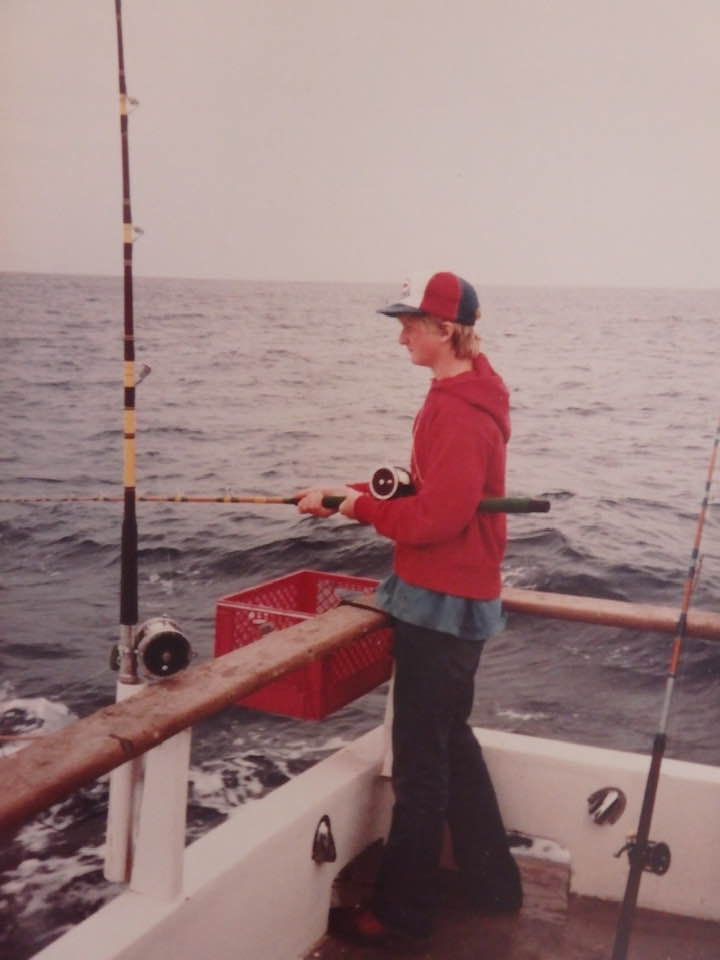
BY BUD CHADDOCK
Baldy’s jigs were a saltwater fixture in commercial sportfishing and sport fleets from the early ‘40s to the late ‘80s before evolving into the tackle we use today. Now we have improved hardware with modern composite diving lips and bodies like the Nomad DTX, with various depth lips for various depth use as well as marauder types to use while fishing for albacore.
The Baldy was made from the early ‘40s to the ‘50s, and it was molded and shaped like many bone jigs made in Japan. The jig had a shape like the modern form as well as an old form of a Starman Candy Bar jig with some modifications. They are also like the bone jigs Jed Welsh made and sold for both albacore and barracuda trollers for the commercial fleets of the day, known back then as the Mosquito Fleet. The Jed Welsh jig was also popular as a sportfishing jig to use on rod and reel as it had more weight than the Baldy did at that time.

The Baldy was made of plastic with a Garwood double long shank hook. Most were barbless that were fastened by a screw in the area of the hook, which was the eye of the hook. The back of the hook was tied down to the tail of the jig and wired with either stainless, copper, or brass to stabilize the hook from moving from side to side, like many single hook jigs we use today. The front had a brass or copper grommet with a welded ring through it in which to attach a line. Sizes were most commonly 4¾ and 6¼ inches long. They came in many colors. Some were translucent in either one color or a combination of blended colors. They also made solid opaque colors in different hues. There were also variations in shapes. Some were surfboard-shaped or more rounded at the front like common bone jigs. My personal favorites were light green/red, and smoke grey/red as they got more action in my opinion. I still have an old chewed-up one I have rewired 6 or 7 times that has caught over a ton or so of fish. It’s been retired for a few decades as times have changed.
I am sure if the Badly was used for albacore today, the way it was intended, it would still catch fish. Many in Southern California today ask, “What’s an albacore?”
Due to current conditions the elusive albacore simply have not shown up “en masse” in SoCal. The NorCal albacore action has been more consistent over the years. The reactive albacore responds more readily to trolling jigs as a whole. And if you have never tasted fresh albacore right off the boat, you’ll appreciate what a Baldy can do.
On a commercial jig boat, Baldy’s would be deployed four fathoms on the inside lines off the stern on each side on a weighted line. On a sportboat, some of you might recall the plastic crates that were on the port and starboard sides of the stern, called boat lines or meat lines with horns attached. Wary, hypnotized trollers were often startled by the blast of the horn when the line was bit, like when a goal is scored in hockey. The jigs were usually in the propwash from that point of entry and were put there to get the fish in quick. On many occasions they were the only ones to get bit over the ones trolled by the passengers with feathers. If it was a slow day, boats would give a fish to a passenger who may not have caught one with rod and reel that day. Somewhat of an insurance policy, I guess.

The boat line that the Baldy was attached to was about 8 feet of 300-pound tuna cord that was hard-laid material from the boat with a strong rubber bungie with a loop that would add shock resistance when the fish struck the jig, thus allowing the bungie to stretch and absorb the strike. Then another 42 feet or so of cord attached to a 2- to 3-pound torpedo sinker with a pigtail swivel that allowed you to attach six feet of 200- to 300-pound mono, which attached to the Baldy. The Badly would drop down into the prop wash underneath the other jigs the passengers were trolling above them. The jig would then kick and swim like that of the modern-day bar jigs we now use for yellowtail and bass. Thus, old into the new era, I guess, as a transition of time. The Baldy was a piece of good fortune some days as it earned its keep as a weapon of choice while pursuing albacore.
It seemed like we always got toads rather than peanuts when using the Baldy. The other reason the Baldy worked well for us was when we had a meter mark we would turn towards it, and it seemed to track the wake a certain way. Also, when on the slide, pulling up on foamers or jumpers as it got bit, the weight would make the jig drop down when we put the boat out of gear as well as making a speed change.
Nowadays it seems like the troll bite — other than kite fishing for bluefin — does not factor as much as the old days. You see less use of traditional trolling feathers today even though albacore were more responsive to them. In addition, NorCal tuna chasers seem to still use them more as they are still successful.
Meter marks with better electronics have made it a different game, along with Flat-Falls and other jigs of that type when used with meter mark fishing of today. When I was working with George Mio on the New Hustler II, we had Wesmar Sonar on loan for research and this was a real game changer. We had more bait stops because of it and did not miss schools off to the side. The feathers back then were Zuker Broom Tails, and the popular colors were root beer, zucchini and Mexican flag. For the bigger albacore and bigeye, we would stack two of them on one line to resemble the sauries in the area.
While fishing on the Pompano, Bill Hilton’s commercial albacore jig fishing boat, we would use the Baldy’s on our short lines. They were between 16 to 24 feet behind the boat, rigged the same way as I described earlier or on a length of chain that was 5 to 7 pounds of large link chain. We could see the Baldy’s working in the pulling pit in the stern and watch the jig in the clear purple 62-degree water an albacore loved. One day, we jigged 312 albacore near the Santa Lucia escarpment outside and above Point Arguello. To my amazement, I watched three bigeye eat those jigs that were on the short lines. Although they were far north, this was not completely unheard of in that time period. The first two that hit were 60 pounds. I got the one into the boat, then tossed the jig back in, and bang, it was already bit while pulling in the twin of the first one. This time the line went straight down and kept up with the boat with violent shakes.

It was time to see what was doing this. It was big. After letting the boat drag it for 10 minutes, we pulled it up and it was a 120-pound model of the twins before it. We double-gaffed it and threw it on board. Then the other side got bit again and the line was ripped off the boat. Another day, we stayed in the area with no other boats nearby. We later called in some friends that were 90 miles away to take in the bite we found. That day we had 3 lines ripped off the boat and 225 albacore in the box. We lost some Baldy’s but to a good cause, and maybe because we had to pay our dues from the day before. Nothing like a tequila sunrise-colored sunset on a calm, not-a-breath-of-wind day to finish an evening of great fishing. I have been blessed by people in the past like Bill Hilton of the Pompano.
Some things are improved by what we have learned in the past, yet the newer methods we use now are helping with better catches. It’s still good to have some of the old ways in your bag of tricks. You never know what might make that day epic.



